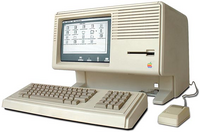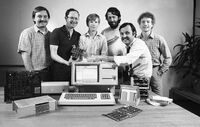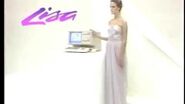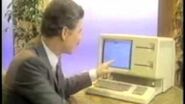
The Lisa 2 replaced the "Twiggy" drives with an 400KB floppy.
The Apple Lisa was a personal computer developed by Apple Computer, targeted at the business market and released on January 19, 1983. This computer was also Apple's first computer to include a graphical user interface (GUI). However, the Lisa failed in part due to its $9,995 USD price tag.
History[]
Development[]

The Apple Lisa development team.
Work on the Lisa began 1978 with Apple co-founder Steve Jobs leading the development team. By September 1980 Jobs was forced off the team and the project fragmented without focused leadership and goals. Research and development costs of the Lisa would reach US$50 million. Jobs then joined the Macintosh team. Although the two products had similarities, the Macintosh survived, due to its lower price and simpler design, although the Lisa lived on for a short year as the Macintosh XL.[1][2]
Release[]

Apple Lisa "Two Kinds of People" - 1983 ad featuring Kevin Costner
The Lisa was released in January 1983 and targeted the business market as the successor to the failed Apple III. Compared to the original Macintosh 128K, which was released in 1984 for educational and home use, the Lisa was slower and more expensive, but contained more memory and was more expandable. This machine had design problems; it had been over-engineered, but it felt sluggish to use. It also included Apple's first attempt at a hard drive, an external 5MB ProFile that was attached through the parallel port and originally developed for the failed Apple III. The Lisa was filled with expansion bays, used sockets for board components and had an open architecture for third party add-ons.[1]
In January 1984, Apple released the Lisa 2/5 series with either a 5 or 10 MB external hard drive, and replaced the pair of expensive and slow 5¼" Apple "Twiggy" floppy drives with a single Sony 3½" floppy drive also used in early Macintosh computers. Apple also released the Lisa 2/10, which came with an internal 10MB hard drive, but no external parallel port. As such, the Lisa 2 came in configurations priced at $3,495 to $5,495, creating a computer half as expensive as the original with improved performance and reliability. At the same time, Apple provided Lisa upgrade kits to Lisa 1 owners free of charge. These upgrades replaced the drives, the bezel, and the ROM chips.[2]
Rebranding and discontinuation[]
In January 1985, Apple re-branded the Lisa 2/10 with an EEPROM update in the upgrade socket, and sold it as the Macintosh XL for $4,000. However, it was replaced in 1986 by the Macintosh Plus.[1]
In 1989, in cooperation with Sun Remarketing, Apple disposed of all unsold Apple Lisa / Macintosh XL units in a controlled landfill site in Logan, Utah, to claim as a tax writeoff.[2]
Naming[]
The name LISA was officially described as an acronym of "Local Integrated Software Architecture". Lisa was also the name of the daughter of development team member Larry Tesler. Steve Jobs denied that the computer was named after his daughter Lisa Brennan-Jobs while contesting a child support lawsuit. Jobs later admitted that he was her father and that the computer was named after her to rock musician Bono. Other development team members, such as Andy Hertzfeld used the backronym "Lisa: Invented Stupid Acronym".[1][3]
Models[]
Apple Lisa[]
This was the original model, and it didn't sell well.
- Available January 1983 - December 1983
- $9,995 USD
- 5MHz Motorola 68000 CPU
- 1MB RAM
- Optional external Apple ProFile 5MB or 10MB hard drive
- Two Apple FileWare "Twiggy" 5.25-inch double-sided floppy disk drives
- 4-bit real-time clock (supporting dates from 1981 to 1995)
Apple Lisa 2/5[]
The simplified Apple Lisa
- Available January 1984 - December 1984
- $3,995 base model price, up to $5,995 with options added
- 5MHz Motorola 68000 CPU
- 512Kb RAM, expandable to 2MB RAM
- External Apple ProFile 5MB hard drive
- Internal Sony 400Kb 3.5-inch MicroFloppy drive
- 4-bit real-time clock (supporting dates from 1981 to 1995)
Apple Lisa 2/10[]
The last in the series; It's the Lisa, but it's a Mac.
- Available January 1984 - December 1984 as the Lisa 2/10
- $5,995
- Available January 1985 - April 1985 as the Macintosh XL
- $3,995
- 5MHz Motorola 68000 CPU
- 1MB RAM, expandable to 2MB RAM
- Internal 10MB Widget hard drive
- Internal Sony 400Kb 3.5-inch MicroFloppy drive
- 4-bit real-time clock (supporting dates from 1981 to 1995)
Software[]
The Lisa came with a bundle of seven software applications, running on top of a modified Apple SOS with a GUI called the Lisa Office System, an operating system that featured protected memory and pre-emptive multitasking. The seven software applications included were LisaWrite (word processing), LisaCalc (spreadsheet), LisaDraw (vector graphics), LisaGraph (graphing), LisaProject (project management), LisaList (to-do lists), and LisaTerminal (terminal emulator for network communications).
The operating system was document-based instead of application-based, similar to Apple's OpenDoc platform for the Mac OS a decade later; you created a new document by cloning a stationary document that included the objects and features you desired in your final product.
Unfortunately, the operating system suffered from heap overflows and memory congestion, and so often crashed when large documents were being used.
A separate OS called Lisa Workshop was sold as the development environment. This OS could be run to develop Lisa software, and later was used to develop the Macintosh System and early Macintosh software. Around 1986, the Lisa Workshop was replaced with the Macintosh Programmer's Workshop which ran inside the Macintosh operating system.
Starting in 1984, Apple also sold the MacWorks Macintosh virtualization environment, which allowed Lisa computers to run Macintosh software. MacWorks 1.0 ran System Software 0.1, MacWorks 2.0 ran System Software 0.3 and 0.5, and MacWorks 3.0 ran System Software 0.5. When the Macintosh XL was released in 1985, MacWorks 4.0 was released as MacWorks XL, and provided support for the internal 10MB hard drive and ran Macintosh System 0.7. It was capable of running every Macintosh system through System Software 1.1. Sun Remarketing later released MacWorks Plus 1.1 which added support for System 5 and 6. Dafax Processing Corp released MacWorks Plus II, which supported up to Mac OS 7.5.5.
Video gallery[]
References[]
- ↑ 1.0 1.1 1.2 1.3 Apple Lisa by Christopher Dernbach, Mac History. 2007-10-12.
- ↑ 2.0 2.1 2.2 Why Are 2700 Apple Lisa Computers Buried In A Landfill? by Aditya Tiwari, Fossbytes. 2016-04-21.
- ↑ Here's the Moment Steve Jobs Finally Admitted Apple's Lisa Computer Was Named After His Daughter by Alex Fitzpatrick, Time. 2018-09-05.
External links[]
- Lisa/Lisa 2/Mac XL at Apple-History
- Apple Lisa and Lisa 2 / Macintosh XL at the Apple Museum
- Hardware: Lisa (German) at The Dot Eaters (archived 2013-07-04)
- Apple Lisa I/O processor firmware, partially reverse-engineered at GitHub
- Apple Lisa at Low End Mac
- Lisa at the Mac Mothership
- Apple Lisa at Steve's Old Computer Museum
- Apple Lisa at Wikipedia
Articles[]
- The Legacy of the Apple Lisa Personal Computer: An Outsider's View by David T. Craig at Oberlin College Computer Science Department (1993-02-16)
- Jan. 19, 1983: Apple Gets Graphic With Lisa by John C. Abell at Wired (2010-01-19)
- Happy birthday, Lisa: Apple's slow but heavy workhorse turns 30 by Bob Dormon at The Register (2013-01-18)
- 30 years of the Apple Lisa and the Apple IIe by Benj Edwards at Macworld (2013-01-18)
- Remember Apple’s Lisa, The Computer That Cost Steve Jobs A Gig? Kevin Costner Does! by David Lumb at Fast Company (2015-01-12)
- This 1983 Demo Says So Much About Apple’s Past, Present, And Future by Harry McCracken at Fast Company (2018-01-26)
- Today in Apple history: Apple launches ill-fated Lisa project by Luke Dormehl at Cult of Mac (2019-07-30)



